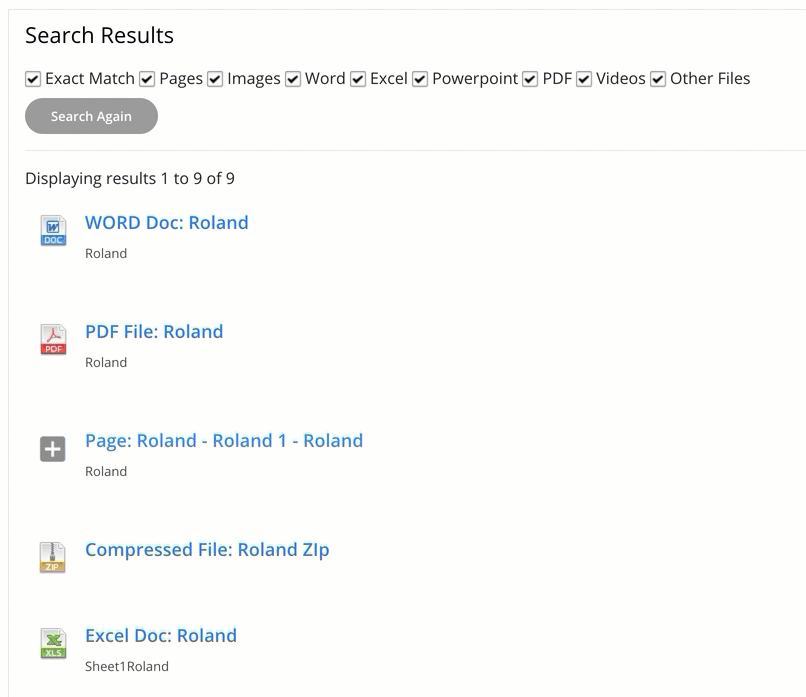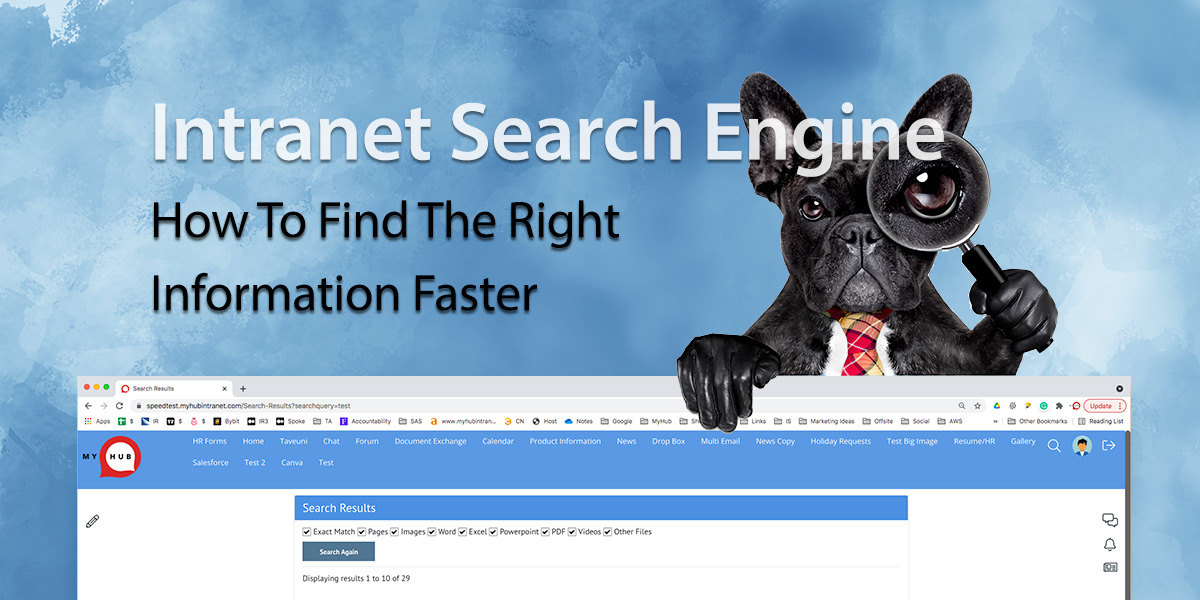Finding information on the internet without Google would be like wading through mud, right? And the same applies to your employee intranet. Without a decent intranet search engine, your intranet will be a chaotic mess. Staff will feel frustrated and irritated. And the impact on your business in lost productivity, poor collaboration, and information overload becomes significant.
An intranet search engine ensures you deliver the right information to the right employee at the right time.
In this post, we share our top tips on getting the best out of your intranet search engine.
Understanding Employee Search Intent
To enhance the performance of your intranet search engine, you must first understand how employees search for content.
Every worker is different, but there are several ways staff typically use the search engine.
Specific Searches
This is perhaps the most common way to find information. Workers have a good idea of what they are looking for and use keywords, tags, or file names to find it. For example, an employee looking for a product manual will type in ‘model ABC product manual.’ And the intranet search engine does the rest.
Non-specific Search
In this type of search, employees have a vague idea of what they are after but don’t have the details. They probably have some keywords; however, they lack the specifics that search engines love. Using the example above, if the employee just typed in ‘product manual,’ they would likely be presented with hundreds of results.
Author Search
Employees often search by the document’s author. For example, they know Joe in Marketing published a report on a recent social media ad campaign. However, a search by author name throws up all the content Joe has published on the intranet. And given that Joe is an active content creator, that’s a lot of results to sift through.

Self-generated Content
Active content creators like Joe will search for their own intranet content from time to time. This works well if the employee has specific details. However, if the content is not accurately tagged, then Joe will also be presented with several pages of results to go through.
An effective intranet search engine is geared up to employee search intent. And it will help you avoid those time-wasting and frustrating hit-and-miss searches.
There are several ways you can find out more about how your staff search for information.
Behavior Analytics
These metrics provide valuable information on how workers are using the intranet search engine. Find out about common keywords and search terms and the most popular content. Understanding users’ needs and behaviors allow you to maximize the intranet search engine’s potential.
Employee Interviews
From time to time, check in with a cross-section of employees and explore how they use the intranet search. An employee interview allows you to dig deep into user behavior and find out what makes them tick. Be sure to also ask for their suggestions on improvements. The insights gained from employee interviews will help refine your intranet search engine.
Employee Surveys
It’s not always feasible to interview every employee. A pulse check or employee survey provides a broader sense of what’s important to the workforce from the search engine. And it means you can easily reach remote workers or those in non-desk roles.
10 Ways To Improve Your Intranet Search Engine
Most cloud intranets come with an integrated advanced search function. All employees have to do is type in a request, and within nanoseconds, they receive the answer. While your intranet search engine already works perfectly well, the following steps will ensure it performs even better.
1. Tag Content
Tagging content is the single most important way you can enhance the intranet search engine. Use keywords and author bylines to label and identify content. This makes it easier to find information and improves search relevancy. However, watch out for typos! A misspelled word in a tag can undo all that hard work.
2. Utilize Company Acronyms
Most businesses have their own internal language and often use acronyms. HR and R&D are common examples. Company-relevant acronyms are another way to tag and categorize content.
3. Use Strong Headlines
Headlines that accurately reflect the content make searching a whole lot easier. For example, your employee wellness strategy may have a snappy title such as ‘A Healthier You.’ However, to improve discoverability on the intranet search engine, include a more detailed descriptor. The headline ‘A Healthier You: 2021 Employee Wellness Strategy’ helps your intranet search engine deliver better results. And it also provides the user with a fuller picture of the content.
4. Use Search Results Filtering
Search filtering options allow you to filter results by a range of common file types and pages. You can easily eliminate any irrelevant file types by unticking the relevant box. This helps you to target your search even more.
5. Regularly Declutter
Review your intranet regularly and get rid of any outdated content. An intranet that has ten different marketing strategies going back over several years just slows things down. And it impacts the relevancy of search results. Make decluttering a priority task for departmental intranet administrators.
6. Quick Previews
Much like Google, a content preview allows users to quickly scan content without wasting time opening it. Users can determine at a glance whether or not the results are useful.
7. Link Related Content
Linking related content and pages improves discoverability. Workers will be exposed to relevant content they may not have known about.
Intelligent intranet search engines like MyHub’s allow you to control search results based on job roles and responsibilities. Permission-based security controls ensure users only access appropriate results. As well as improving relevancy, this means staff cannot accidentally access secure information.
8. Make The Search Bar Accessible
Ensure the search bar is visible and accessible from every page. You want to make it as easy as possible for employees to find what they need. The best place to showcase the search is to position it in the header of the intranet navigation.
9. Train Staff
Often workers, especially new recruits, are not fully aware of the intranet search engine’s capabilities. How-to videos or lunch and learn events are easily implemented ways to ensure staff get the most out of the tool. And make training on the intranet search engine a central part of the onboarding process.
10. Track Search Analytics
Be sure to track search usage analytics. This provides a wealth of information on what users want and how they use the intranet search engine. Keeping an eye on the analytics helps you identify user behavior and any underlying trends. You will then be better placed to refine and improve the search function and ensure it’s fit for purpose.
Investing time and resources on the intranet search engine is well worth the effort. Quite simply, it can make or break your company intranet.
Here are five reasons why your intranet search engine is critical to business success.
Intranet Search Engine: 5 Reasons Why It’s So Important
1. Improved Productivity
Time spent searching for information is time wasted. It’s a simple equation. The faster your staff can source data, the more productive they will be.
According to Forbes, knowledge workers waste 19 percent of their time searching for and gathering information. And for a double whammy, managers often spend a lot of time supporting team members. And inevitably, that involves answering the ‘where is that file’ type of question.
An effective intranet search engine means employees can work independently and more efficiently and effectively. And it also means managers have more time to spend on what really matters.
2. Reduced Information Overload
Information overload is an increasing workplace issue. One study found that 18 percent of respondents feel stressed by information overload. And eight percent said they can’t unplug and are dealing with information 24/7. Stress and burnout are the inevitable consequences for a growing number of workers. Plus, your employer brand and, ultimately, company profits are also at stake.
Targeted intranet search engine results have a critical role to play in managing information overload. It means employees are not overwhelmed and dragged down by irrelevant information and data.
3. Improved Employee Engagement
Research from Gallup confirms that one of the key drivers of employee engagement is having the materials and equipment to do the job right. Employee engagement becomes a whole lot easier when employees can quickly and easily source information. Increased job satisfaction and enhanced team spirit naturally follow.
So, if you are looking to improve employee engagement, then the intranet search engine is a great place to start.
4. Better Customer Service
Ready access to company information and data means customer-facing staff can provide more responsive services. Take, for example, a service technician working in the field. When faced with a challenging problem, a quick search on the mobile intranet provides the answer in a flash. And the customer is super happy with the speedy and responsive service.
5. Enhanced Cross-Team Collaboration
With hybrid working now commonplace, cross-team collaboration is more critical than ever. Improving your intranet search engine streamlines cross-team collaboration.
The best intranet search engines also crawl shared intranet project spaces and forums. Therefore, team members have instant access to vital data. They can quickly locate files and even search conversations in the team chat. And for remote workers operating in isolation, this ability is crucial.
Make sure your intranet search engine also offers personalized preferences.
And for the business, the result is a more agile and effective collaboration driven by comprehensive search results.
Intranet Search Engine: Main Takeaways
The search function is a critical component of your intranet. You may have fantastic, high-quality content. However, if employees can’t find what they need, the success of your entire intranet is on the line.
As your intranet grows in popularity and user numbers increase, more and more content is added. Your intranet search engine will be working harder than ever to continue delivering the results you expect.
Taking the simple steps we have outlined here will ensure your intranet search engine’s performance is future-proofed.
Here’s a quick summary of what we have covered.
- Improve discoverability and relevancy with full titles, results filtering, and quick previews.
- Ensure the search bar is visible and accessible.
- Declutter regularly and get rid of outdated content.
- Train staff in how to get the best out of the intranet search function.
- Understand user search intent.
It’s well worth making an effort. Less time wasted on locating data means staff can focus on what matters – getting the job done.
MyHub’s cloud intranets come with a state-of-the-art intranet search engine. Our beautifully designed, easy-to-set-up intranets ensure your staff find the correct information faster. Sign up for a free demo or no-obligation 14-day trial. And find out how MyHub’s intranet makes locating content easy.










